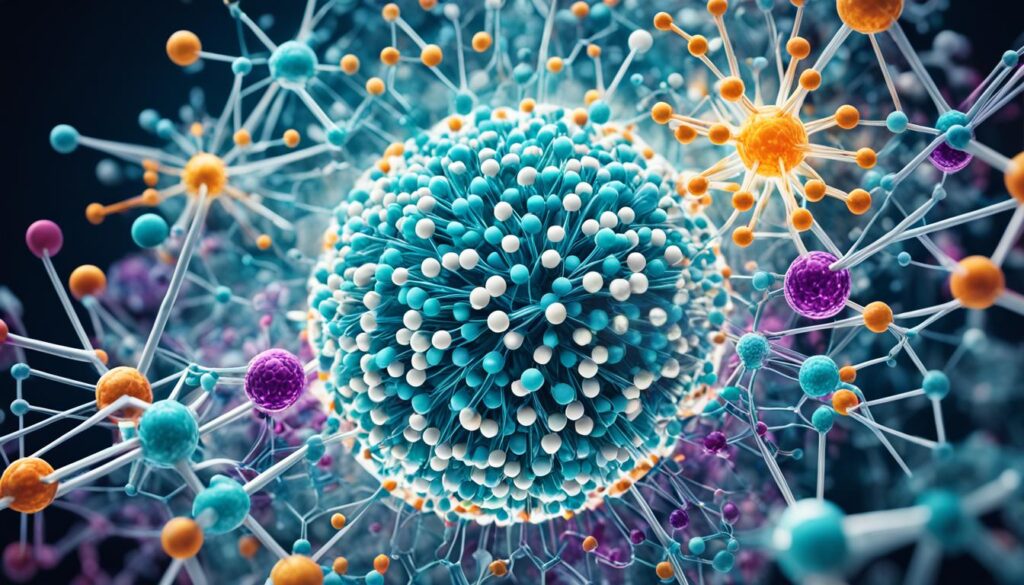The world of drug development is at the edge of a big change. This is thanks to quantum computing. It’s bringing a new level of speed and accuracy to finding new medicines. The Quantum-assisted Fragment-based Automated Structure Generator (QFASG) is leading this change. It’s a top example of the new wave in designing drugs.
Insilico Medicine created QFASG. They used complex chemoinformatics and AI to build it. It’s designed to come up with drug candidates ready to take on tough diseases.
Insilico’s QFASG is more than a small improvement. It’s a big jump forward. It shows the powerful role of quantum computing in exploring the huge chemical space. QFASG’s detailed process helps find key inhibitors against cancer proteins. This paves the way for a future where AI and quantum tech transform drug making.
Introducing QFASG: A Paradigm Shift in Drug Discovery
The world of drug development is changing fast, thanks to new tech like Quantum-assisted Drug Design Breakthroughs. The leader of this change is Insilico Medicine’s tool, called Quantum-assisted Fragment-based Automated Structure Generator (QFASG). It’s making it much quicker to make new drugs. With quantum algorithms for drug development, QFASG is more than just an upgrade. It’s a whole new way to think about making medicines.
QFASG brings something new to the table with its Chemistry42 engine. This engine blends artificial intelligence with chemistry. It finds new ways to design drugs. It’s great at making new, drug-like structures that work well with certain proteins. This speeds up discovery and gives us more options for treatment. It shows QFASG is changing how we find and develop new drugs.
QFASG is also about speed and being efficient, things the drug world really needs. By using quantum algorithms for drug development and other modern methods, it’s changing old ways of working. It means we can go from ideas to real drug candidates faster. In short, QFASG and its groundbreaking Quantum-assisted Drug Design Breakthroughs are creating new routes for future medicines to come to life.
The Role of AI and Quantum Mechanics in Pharmaceutical Research
The field of pharmaceutical research is changing fast. We’re seeing quantum mechanics and AI drug discovery come together. This mix is changing how we develop drugs. Insilico Medicine is leading the way. They use AI to quickly find new targets for treatment and design complex molecules.
Quantum computing and AI are a powerful team. Together, they let scientists speed up their work on chemical structures. This partnership helps us better understand how molecules interact. It’s making the search for new drugs faster and more precise. By using quantum-powered simulations, we can look at molecules in more detail. This improves how we discover drugs.

Combining quantum mechanics in pharmaceutical research with AI opens up new paths. It helps us explore uncharted areas of chemistry very effectively. As these technologies get better, we move closer to making new, life-saving drugs more quickly and cheaply. This is starting a new chapter in healthcare that could greatly benefit patients.
Innovative Drug Design Technologies: The Impact of QFASG
The rise of innovative drug design technologies like QFASG is a game-changer. Developed by Insilico Medicine, QFASG uses quantum-enhanced molecular simulations to make better drugs faster. It builds large libraries of compounds quickly, making drug discovery more efficient and accurate.

QFASG stands out because it finds and improves possible drug candidates. This process goes beyond finding initial compounds. It includes important steps like optimizing the best leads. The use of quantum-enhanced molecular simulations marks a big shift in how we design drugs.
Quantum computing dives deep into chemical bonds and reactions. This gives scientists valuable, in-depth information. Combining quantum mechanics with smart algorithms brings the best in drug development today. It gives research teams a big edge in creating new treatments.
Targeting Cancer: QFASG’s Success in ATM and CAMKK2 Inhibitors
Quantum mechanics has changed how we fight cancer. The Quantum-assisted Fragment-based Automated Structure Generator (QFASG) at Insilico Medicine is a key example. It uses quantum computing to design new inhibitors for ATM and CAMKK2 kinases. These proteins are important in cancer development. QFASG’s work is leading the way towards a future where quantum methods could dominate drug making.
QFASG focuses on important enzymes like ATM and CAMKK2 that help cancer grow. Researchers have made compounds that work well against these kinases. They found these compounds not by chance, but by smart, quantum-enhanced analysis. This way of finding new drugs could change how we handle diseases like cancer.
QFASG gives us hope for better cancer treatments. Its success proves quantum-assisted methods work. It shows we can find new drugs faster with this tech. As we use more quantum computing in medicine, tools like QFASG become more important. They’re part of a big change in how we find cures for diseases.
